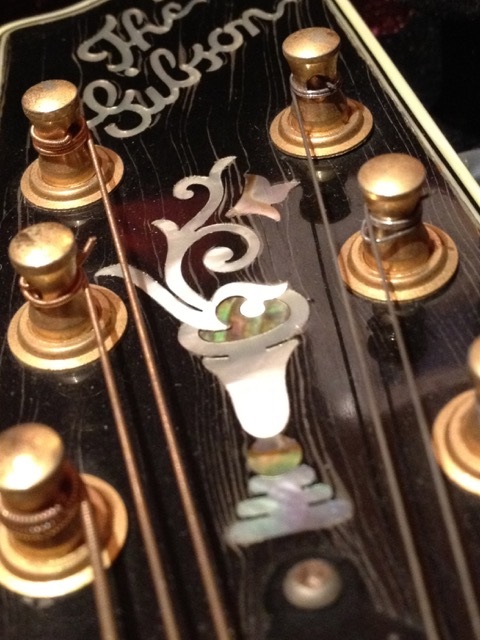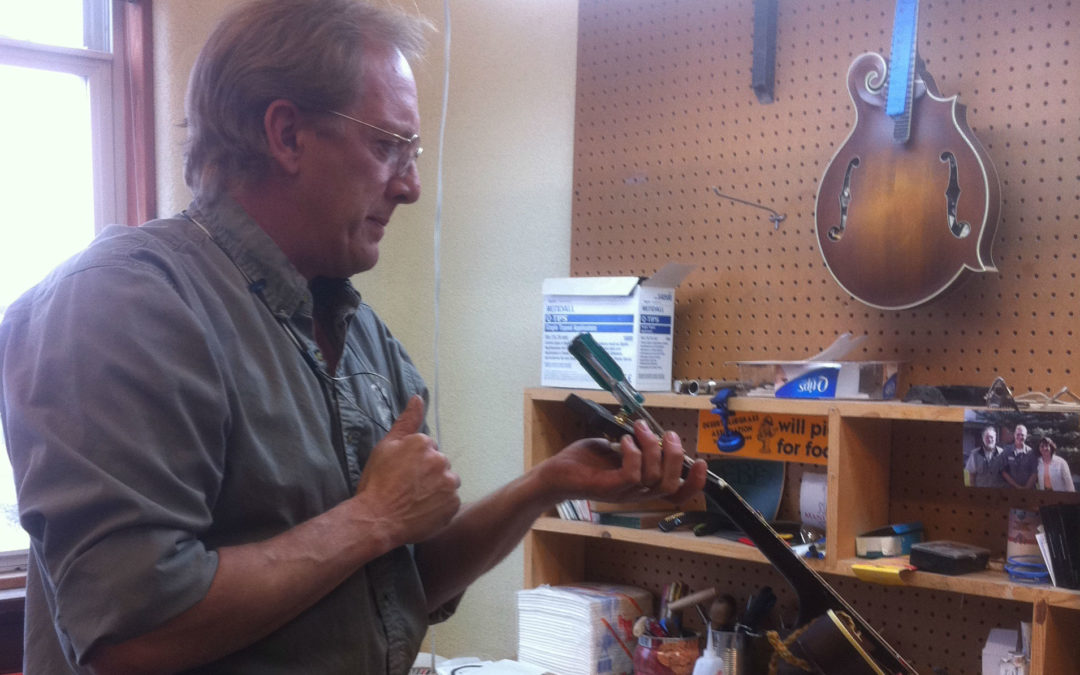
SpeedNecking- a Story
By Brian Beker
One score and seven years ago, I sold a Lloyd Loar F-5. Included in the deal was a brand-new Gibson A-5L. The A-5 was okay, but that was it, and not because I was spoiled by the Loar. As a new mandolin, it was just holding something back, and I expected it to open up. It took years, but eventually it developed a pleasing, though never exceptional tone. The worst thing about it was its thick neck, a sharp V-profile under heavy, high-gloss lacquer, which created lots of friction. Every time I played that mandolin, for a quarter of century, I regretted that neck.
A well-regarded luthier turned down my request to reshape the neck, saying that its integrity would suffer. I took his word for it and kept playing until that sharp V started to hurt my hand. The mandolin started spending a lot more time in the case.
This was heartbreaking. It was my only mandolin. It had traveled the world with me. It had been in all of the Lower 48, in Europe, all over south and southeast Asia, even on the back of a motorcycle for a 6000-mile motorcycle trek through India and up to nearly 19,000 feet to the Tibetan plateau. I was never much good as a player, but I loved playing and didn’t like to go anywhere without my mandolin.
You know how you look inside your mandolin from time to time? I’m not sure what it is anyone might expect to see there, but it’s part of being a mando player and if you’re reading this, you probably know exactly what’s in your f-holes like I do. In mine, there are the Gibson factory labels, signed in 1990 by Steve Carlson.
A few months ago, out camping with my dog in east Oklahoma, I tried playing the thing. That sharp V dug in. It seemed like it was going to cripple my hand with permanent nerve damage. It occurred to me to track Steve down and ask him if there was room to safely trim the wood. Steve wrote back to say he took his old A5-L out to look it over, and sure, it could be done. He warned me, though, that it might look a little funny because of the way the flat of the back of the peghead tapers into the V of the neck.
Steve suggested asking Bruce Weber to do it. Had this not been an actual conversation, that’s when I would have said, “Bruce Weber? The Bruce Weber?”
I looked Bruce up online. Montana Luthiers did not yet have a web site, so he wasn’t where I emailed him.
I didn’t hear back. I wasn’t surprised. Yeah, right… Bruce Weber, whose name has faced countless audiences on the pegherds of countless prized mandolins in the hands of great players, was going to file a neck down for some guy whose only audience is a dog who looks like she wants to be returned to the shelter every time the mandolin comes out.
In the meantime, I was waffling anyway. What if I actually got the job done and didn’t like it? There wouldn’t be any going back. Maybe I ought to just leave it alone. Find another mandolin. Trade it in and done with it. No, couldn’t do that. It had been with me too long. It had weathered and aged, the finish was checked. If it wasn’t for that awful neck, it was beautiful. There just had to be a good mandolin wrapped up in that one.
But then (the poor dog and I were camping in West Virginia by then), the phone rang. It was Bruce. It had taken someone some time to forward my email to him., but as soon as he got it, he called.
The amount of time Bruce spent on the phone with me must have set his building schedule back. He wanted to make sure I had every opportunity to try to convey what I hoped for. Just talking about getting rid of the painful V made me feel better. And the gloss lacquer? Begone! I expected the raw wood look of a speedneck to be on the annoying side, but that mando was already as uniquely worn as an old boot. So what if it got a little weirder.
He said he’d be happy to do it. I shipped the mandolin to him from a little country post office up in the panhandle on a Friday.
Bruce let me know when got the mando on the following Monday. By Tuesday he was texting me progress pictures. When the wood was trimmed, he sent another picture to ask if he should apply a touch of tint to bring out the figuring in the maple or leave it blonde. We went with a light tint. And then another photo when that was done. In the course of our talks, we had begun to discuss a favorite topic for both of us — dogs — and Bruce texted me a picture of his new puppy Ranger playing in my packing material.
It was looking good. When Bruce got it strung up, he determined that the original pearl nut was producing a slight buzz (I had been suspecting one and could never figure it out) and asked if he should change it. My choice: bone or pearl. He said bone wouldn’t last as long but would warm the tone up a bit more. I went with bone.
On the Friday of that same week, the mando arrived (in Maine, then) via Priority Mail. That’s worth repeating: Bruce got it on Monday in Montana and I had it back, by Friday of the same week, without expressing it.
I was surprised at how anxious I was when I unpacked it. I mean, I might have asked for something that I might not have liked. I would know the second I put my hand around the neck.
And it did, in fact, take only a second. It was the neck I had hoped for. The only mandolin I had ever played that it resembled was the one on my old Loar. Even with the strings still detensioned for shipping, I knew this was perfect. And though some folks might not find the way the black finish at the heel and top of the neck on any speednecked mandolin might look, it’s beauty surprised me. Much more so than the bulletproof lacquer there was before (by the way, the nitro on the body isn’t like that at all – it’s finished beautifully). The tiger-striped grain in the maple shifts in the light. Why such a beautiful piece of wood was ever covered up is a mystery.
Steve Carlson’s warning about the neck looking odd where the flat of the back of the peghead meets the neck, was handled perfectly by Bruce. He sculpted it beautifully to preserve the V at the bottom of the peghead. There is no indication of any line being off at all. It is artistry. The feel of the quality of the instrument was changed entirely.
On the change in playability from speednecking: the before and after is mindblowing. All friction is eliminated. Position shifts that I used to believe were beyond me are coming easily. The difference in no hand drag is huge. It is as great an improvement as the flatter neck profile is.

In case you’re wondering just how big a bribe it took to get someone of Bruce Weber’s caliber to do the neck, replace the nut, dress the frets, take the action down as far as it would go (what a great setup this mandolin has now!) and swap out the tuners for some play-at-home hobby player — and do it in two days… well, I’d rather not say. I’d hate to alert him to what might well have been a serious accounting error in my favor. I doubt that, though. I think Bruce and Mary just don’t suffer from the affliction of greed.
All in all, nothing about this whole escapade was less than ideal. Master luthier perfectly enhances mandolin to where I now love it. It sounds, feels, and even looks, better than it ever did. I don’t know if a bone nut can account for that much of a difference or if the removal of some wood or the finish does, but it is ten times the mandolin it ever was. I’m so glad I held off until fate and Steve Carlson steered me to Bruce. Bruce justified all my hopes in the mandolin, all the time and distance it’s traveled.
So, that’s my once-in-a-lifetime re-profiling and speednecking story. I used to turn that mandolin over and frown at that neck. Now I find myself gazing at it with a smile. It could not be improved.
To be completely honest, though, I should disclose that I did have one issue with the job, which I sent to Bruce immediately as a text that read MAJOR COMPLAINT: (I paused for a few seconds) and then reported that I was still not able to play like Bill Monroe.
Bruce texted back that he had forgotten to put the BM mojo in the box.
Well, at least he didn’t skimp on any of the BW mojo.




